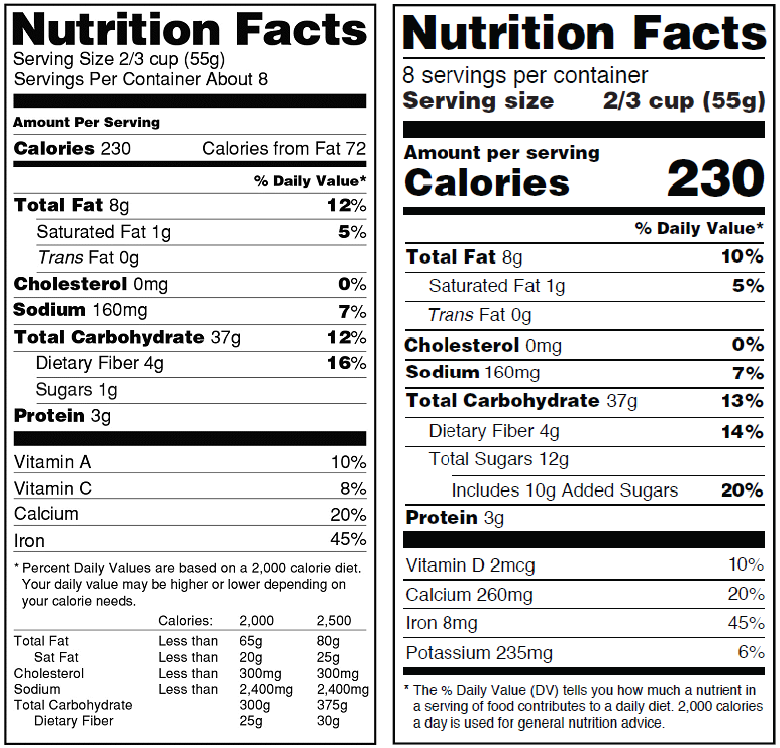Understanding food labels
Consumer interest in food labelling is growing. Unfortunately it is not always easy to understand food labels. The Nutrition Facts food label gives you information about which nutrients are in the food. Your body needs the right combination of nutrients, such as vitamins, to work properly and grow. The Nutrition Facts food label is printed somewhere on the outside of packaged food, and you usually don’t have to look hard to find it.
The Nutrition Panel
This is where you will find the information on the nutrient breakdown of a product. Energy is measured in kilocalories (kcals) and kilojoules (kJ). Other nutrients are shown in grams (g). some nutrients are measured in milligrams, or mg. Milligrams are tiny, there are 1,000 milligrams in 1 gram.
Fats may be broken down into saturated and unsaturated, choose products with a majority of unsaturated rather than saturated fat. ‘Of which sugars’ indicates the amount of refined carbohydrate compared to complex carbohydrate.
Other information on the label is given in percentages. Food contains fat, protein, carbohydrates, and fiber. Food also contains vitamins, such as A and C, and minerals, such as calcium and iron. Nutrition specialists know how much of each one children and adults should get every day to have a healthy diet. On food labels, they base the percentages on a 2,000-calorie adult diet. The percent daily value on a food label tells you how this food can help someone meet these daily goals.
Serving Size
The nutrition label always lists a serving size, which is an amount of food, such as 1 cup of cereal, a hand full of nuts etc. The nutrition label tells you how many nutrients are in that amount of food. Serving sizes also help people understand how much they’re eating. If you ate 2 hand full’s of nuts, that would be two servings.
Calories and Calories From Fat
The number of calories in a single serving of the food is listed on the label. This number tells you the amount of energy in the food. The calories in a food can come from fat, protein, or carbohydrate. Eating excessive amounts of calories will lead to them being stored in the body as fat and can lean to weight gain. Another important part of the label is the number of calories that come from fat.
Total Fat
The total fat is the number of fat grams contained in one serving of the food. Fat is an important nutrient that your body uses for growth and development, but you don’t want to eat too much. The different kinds of fat, such as saturated, unsaturated, and trans fat, will be listed separately on the label.
‘90 % fat free ‘
Do you recognize this common marketing slogan? It means that 10% of the product must be fat. For a product to be labeled low-fat it must be less than 3% fat. So this product is, in fact, high fat. This is not a false claim, but it can lead to impulse buying if you don’t calculate your percentages first.
Total Carbohydrate
This number tells you how many carbohydrate grams are in one serving of food. Carbohydrates are your body’s primary source of energy. This total is broken down into grams of sugar and grams of dietary fiber.
Protein
This number tells you how much protein you get from a single serving of the food. Your body needs protein to build and repair essential parts of the body, such as muscles, blood, and organs. Protein is often measured in grams.
Vitamin A and Vitamin C
These list the amounts of vitamin A and vitamin C, two especially important vitamins, in a serving of the food. Each amount is given as a percent daily value. Other vitamins may be listed on some labels.
Calcium and Iron
These list the percentages of calcium and iron, two important minerals, that are in a serving of the food. Again, each amount is given as a percent daily value and other minerals may be listed on the label.
Cholesterol and Sodium
These numbers tell you how much cholesterol and sodium (salt) are in a single serving of the food. They are included on the label because some people should limit the amount of cholesterol and salt in their diets. Cholesterol and sodium are usually measured in milligrams.
Sometimes manufacturers provide more information on their labels than others. Where a nutrient is particularly abundant in a food, like vitamin C in orange juice, the manufacturer may want to draw attention to the product. Thus a caption like ‘High in Vitamin C’, the quantity of vitamin C must be detailed on the nutrition panel as proof. Health authorities have approved the following health claims. To use one of these claims, manufacturing companies must comply with set criteria.
- Low Fat / 97 % Fat Free = Less than 3g fat in 100g
- Low in Saturates = Less than 3g saturated fat in 100g
- Virtually Fat Free = Less than 0.3g fat in 100g
- Reduced Fat = At least 25% less fat than standard product
- Low Sugar = Less than 5g sugar in 100g
- Sugar Free = No added or naturally occurring sugar
- No Added Sugar = No extra sugar added
- Reduced Sugar = At least 25% less sugar than standard product
- High Fibre = At least 6g fibre in 100g
- Reduced Sodium (salt) = At least 25% less sodium (salt) than standard product
- Low Calorie / Diet = Less than 40 calories in 100g or 100ml
‘Use By’ Dates
You should not eat foods after their ‘Use By’ date as they might not be safe to eat. Microbial changes take place in the food after this time that can put your health at risk.
‘Best Before’ dates are slightly different. This is more to do with quality than safety. It means that the product is best eaten before this date. The flavour or texture may deteriorate after this date but it is not unsafe, with the exception of eggs. ‘Sell By’ or ‘Display until’ dates are used to help staff keep control of stock, this is done by choice and is always in addition to ‘Use By’ or ‘Best Before’ dates.
Special Dietary Needs
Warnings on packaging help those with allergies or intolerance’s to avoid certain ingredients. The phrase ‘May contain’ limits food choice even further, because allergy sufferers cannot put themselves at risk of ingesting something that they may cause them to have an allergic reaction. As it is difficult for manufacturers to guarantee a completely gluten-free product, the gluten free symbol is not often volunteered. The Vegetarian Society permits products that comply with their regulations to use their logo. ‘Suitable for Vegetarians’ is voluntary but must be used honestly.
Pictures on Food Packaging
The pictures on packets and labels must not be misleading. This is a very straight forward way to tell real from artificial. A strawberry yogurt that gets its flavour from artificial flavouring, and not from fruit, is not allowed to have a picture of strawberries on the pot.
Read the Labels
So the next time you do your grocery shopping, compare another product to your usual brand of product and see if there is a difference! You just might be surprised!
If you are not sure about where to start click this link and find out how me may be able to help



